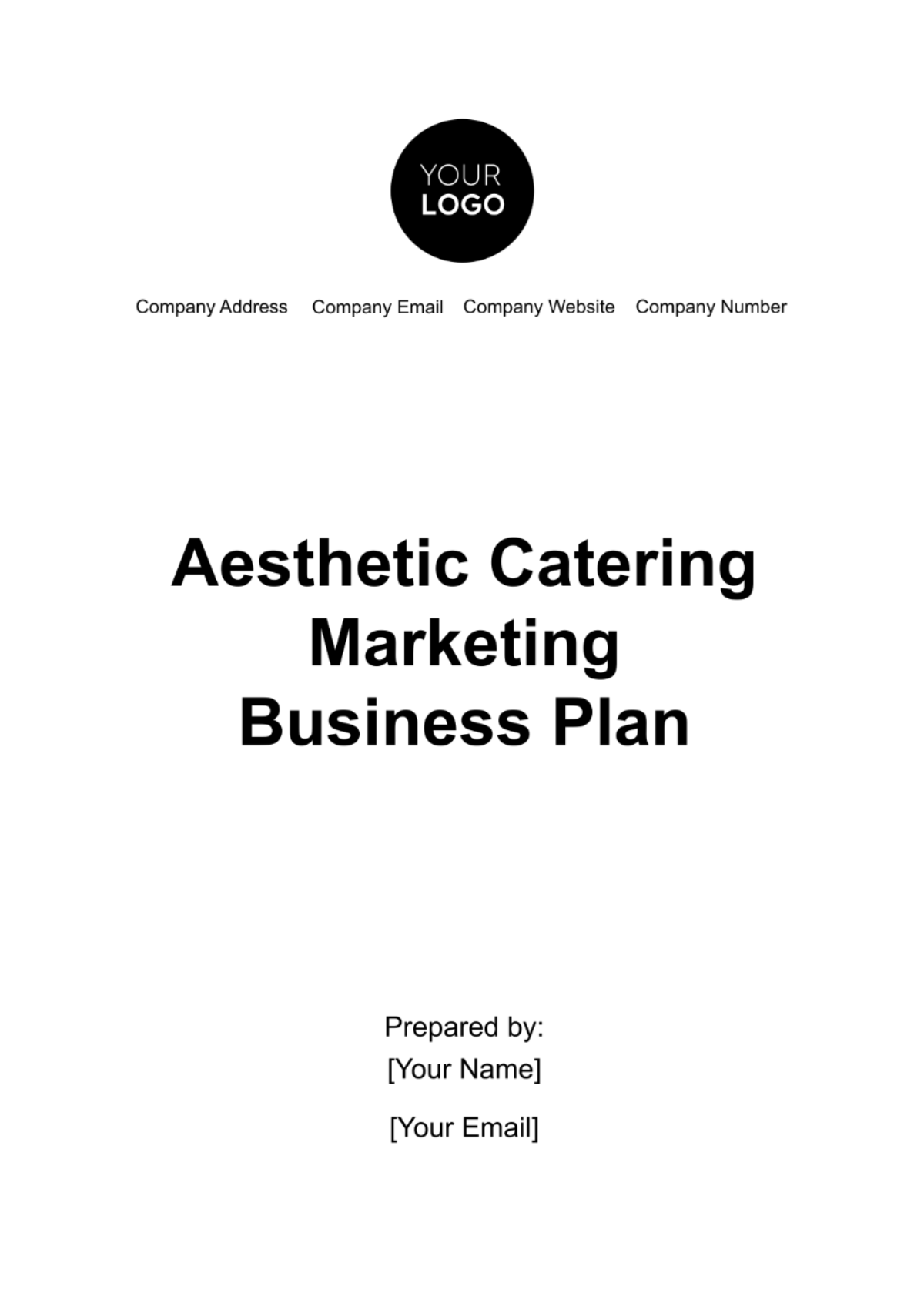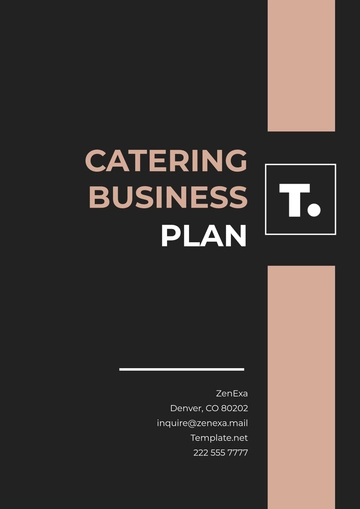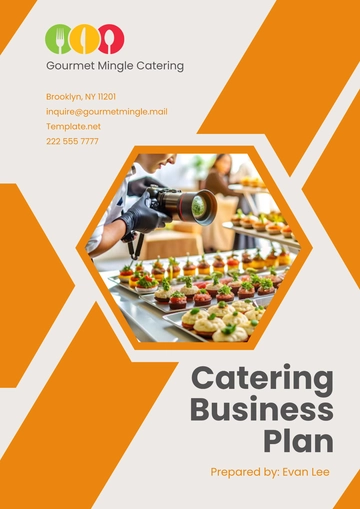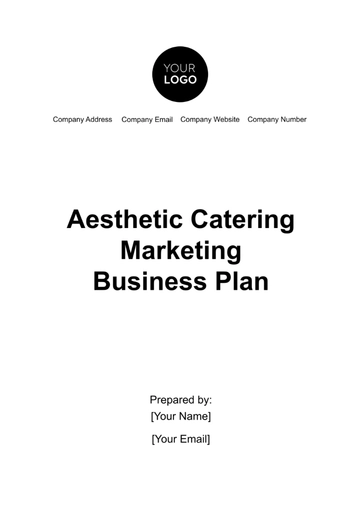Free Aesthetic Catering Marketing Business Plan

I. Executive Summary
A. Business Overview
[Your Company Name] is a premium catering company dedicated to delivering unparalleled culinary experiences that elevate any event. With a strong commitment to quality and creativity, we offer a diverse range of gourmet menus, each tailored to meet the specific needs and preferences of our clients. Our mission is to transform ordinary events into extraordinary memories by combining exceptional food with impeccable service. We envision becoming the go-to caterer for high-end events in our region, recognized for our attention to detail, innovative offerings, and unwavering commitment to customer satisfaction.
B. Business Goals
In the short term, our primary goal is to increase monthly bookings by [00]% within the next year, leveraging targeted marketing efforts and strategic partnerships. We also plan to launch a new seasonal menu by the next quarter, highlighting fresh, local ingredients to attract health-conscious clients. In the long term, we aim to expand our service coverage to two additional cities within the next three years, positioning [Your Company Name] as a regional leader in the industry. Additionally, we aspire to establish a flagship event space within the next five years, providing a dedicated venue for hosting premium events and further solidifying our brand’s reputation.
C. Marketing Objectives
Our marketing objectives are centered around increasing brand awareness, acquiring new clients, and enhancing customer loyalty. We aim to boost brand visibility by [00]% within the next year through a comprehensive digital marketing strategy, including social media campaigns and SEO optimization. We plan to acquire 50 new corporate clients within the next 12 months by offering tailored packages that meet the specific needs of business events. To measure our success, we will track key performance indicators such as website traffic, social media engagement, and lead conversion rates, ensuring that our marketing efforts are effectively driving growth.
II. Market Analysis
A. Industry Overview
The catering industry is experiencing significant growth, driven by increasing demand for specialized and themed event services. Current market trends indicate a strong preference for sustainable and organic catering options, as clients become more health-conscious and environmentally aware. The industry is also seeing a rise in the popularity of experiential dining, where the focus is on creating unique, immersive experiences that go beyond just food. With an annual growth rate of [00]%, the catering market presents ample opportunities for businesses like [Your Company Name] to innovate and capture a larger share of the market by catering to these emerging trends.
B. Target Market
Our target market comprises middle to upper-middle-class individuals and businesses located in urban and suburban areas within a 50-mile radius of our base. Our main clients are aged 30-60 with disposable income, seeking quality, personalized, and sustainable catering for upscale events. They frequently host or attend such events and prefer reputable caterers for exceptional service.
C. Competitive Analysis
[Your Company Name] operates in a competitive landscape, with key competitors such as [Competitor A] and [Competitor B] offering similar high-end services. Our unique focus on locally sourced, organic ingredients, and customizable menus sets us apart. A SWOT analysis indicates strong brand recognition and loyal clients but highlights challenges like limited geographic reach and higher prices. Opportunities include expanding services and locations, while threats involve economic downturns and rising competition. To stay ahead, we must keep innovating and offer superior service and products.
III. Brand Positioning and Strategy
A. Unique Selling Proposition (USP)
Our unique selling proposition lies in our ability to create fully customized gourmet menus that reflect the specific tastes and preferences of each client. Unlike many competitors, we offer flexible and creative catering that can be fully personalized. Using only fresh, locally sourced, organic ingredients, we ensure high quality and sustainability. This makes [Your Company Name] the top choice for a unique and exceptional dining experience.
B. Brand Identity
The brand identity of [Your Company Name] is built around the concepts of luxury, sophistication, and warmth. Our brand name and logo, featuring a refined fork and plate design, encapsulate the elegance and quality that we bring to every event. Our brand voice is professional yet approachable, conveying a sense of reliability and excellence while maintaining a personal touch. Visually, our brand is represented by a rich color palette of burgundy and gold, which evokes feelings of opulence and celebration. This cohesive brand identity helps us stand out in a crowded market and resonate with our target audience, who seek not only exceptional food but also an exceptional overall experience.
C. Customer Experience
At [Your Company Name], we believe that every client interaction should reflect our commitment to excellence and attention to detail. From the initial consultation to the final event execution, we focus on understanding our clients’ needs and exceeding their expectations. We excel in personalized service, offering tailored consultations and detailed event planning with a dedicated coordinator, fostering client satisfaction and loyalty.
IV. Marketing Objectives
A. Brand Awareness
Building brand awareness is crucial to expanding our client base and establishing [Your Company Name] as a market leader. We plan to increase visibility through a multi-faceted marketing approach that includes social media campaigns, search engine optimization (SEO), and strategic partnerships. By showcasing behind-the-scenes content, client testimonials, and event highlights on platforms like Instagram and Facebook, we aim to engage with our target audience and reinforce our brand identity. Additionally, we will invest in local SEO to ensure that our website ranks highly in search results for relevant keywords, driving organic traffic and increasing our reach.
B. Lead Generation
To generate leads, we will implement targeted marketing campaigns that reach potential clients through both digital and traditional channels. Online, we will run Google Ads and social media ads aimed at individuals planning weddings, corporate events, and private parties, using demographic and behavioral targeting to ensure our ads reach the right audience. Offline, we will collaborate with local event venues, wedding planners, and corporate event coordinators to secure referrals and recommendations. Additionally, we will introduce a referral program that incentivizes existing clients to refer new business, offering discounts or gifts as a reward for successful referrals.
C. Customer Retention
Retaining customers is as important as acquiring new ones, and we plan to achieve high retention rates through a combination of loyalty programs and exceptional customer service. Our loyalty program will offer repeat clients exclusive discounts, early access to new menus, and complimentary upgrades, encouraging them to continue using our services for future events. We will also use a customer relationship management (CRM) system to track client preferences, important dates, and past interactions, allowing us to provide personalized service and maintain strong relationships. By consistently exceeding client expectations, we aim to build a loyal customer base that will not only return for future events but also become advocates for our brand.
D. Sales Growth
Our sales growth strategy focuses on increasing both the number of bookings and the average order value through upselling and cross-selling. We will introduce premium service packages that include additional offerings such as event decor, live entertainment, and customized menus, appealing to clients who seek an all-inclusive event experience. We will also explore opportunities to cross-sell complementary services, such as photography and videography, through partnerships with local vendors. By setting clear revenue targets and implementing strategies to achieve them, we aim to grow our sales by [00]% annually, ensuring sustainable business growth and profitability.
V. Marketing Strategies
A. Product Strategy
Our product strategy is centered around offering a diverse and adaptable menu that meets the evolving tastes and preferences of our clients. We will regularly update our menu to include seasonal and locally sourced ingredients, highlighting fresh flavors and supporting local producers. Additionally, we will specialize in catering to dietary restrictions and preferences, offering gluten-free, vegan, and kosher options to accommodate a wide range of clients. Our themed and customizable catering packages will allow clients to choose a menu that reflects the theme and tone of their event, whether it’s a formal corporate gathering or a relaxed outdoor wedding.
B. Pricing Strategy
Our pricing strategy is designed to reflect the premium quality of our services while remaining competitive in the market. We will implement a value-based pricing model, where prices are set according to the perceived value of our offerings, ensuring that clients feel they are receiving exceptional service at a fair price. We will regularly conduct competitive pricing analyses to ensure our prices align with market expectations while maintaining our profitability. Additionally, we will offer discounts and promotions during off-peak seasons and for early bookings, helping to smooth out revenue fluctuations and attract price-sensitive clients.
C. Promotion Strategy
To effectively promote our services, we will use a combination of digital and traditional marketing channels. Our digital marketing efforts will include SEO, social media marketing, and email campaigns, all aimed at increasing online visibility and engagement. We will also invest in content marketing, creating high-quality blog posts and videos that showcase our expertise and provide value to potential clients. Traditional marketing efforts will include distributing brochures and business cards at local event venues, placing ads in regional magazines, and participating in local events. Public relations and media outreach will further enhance our visibility, positioning [Your Company Name].
VI. Sales Strategy
A. Sales Process
Our sales process begins with an initial consultation, where we gather detailed information about the client's event needs, preferences, and budget. This personalized approach allows us to tailor our proposals to each client's unique vision, increasing the likelihood of securing the booking. After the consultation, our team prepares a customized proposal, which includes menu options, service details, and pricing. We follow up with clients to address any questions or concerns, ensuring transparency and building trust. Once the proposal is accepted, we move forward with contract signing and event planning, maintaining close communication with the client throughout the process.
B. Sales Channels
To maximize our reach, we employ a multi-channel sales strategy that includes direct sales, online platforms, and third-party partnerships. Direct sales efforts focus on building relationships with clients through personalized outreach, such as phone calls, emails, and face-to-face meetings, which help establish trust and showcase our commitment to service. Our online sales platforms, including our website, enable clients to easily book our services and make payments, streamlining the sales process and enhancing convenience. Additionally, we collaborate with event planners, corporate agencies, and online marketplaces like Thumbtack to tap into new client pools and expand our market presence.
C. Sales Targets
We have set ambitious sales targets to drive business growth, including both revenue and client acquisition goals. Our aim is to increase quarterly revenue by [00]% through strategic upselling to existing clients and acquiring new clients in targeted segments. To achieve this, we plan to secure 15 new clients each month, focusing on high-value events such as weddings, corporate functions, and upscale private parties. These targets will be monitored closely, and we will adjust our sales tactics as needed to ensure that we remain on track to meet or exceed our goals.
VII. Marketing Budget
A. Budget Allocation
Effective marketing requires a well-planned budget that covers all key areas, including advertising, content creation, events, and technology. We have allocated $[00] annually for digital advertising, with a focus on Google Ads, social media promotions, and local SEO campaigns to enhance our online visibility. We’ve allocated $[00] for high-quality content creation, $[00] for local events and sponsorships to build community ties, and $[00] for CRM software and analytics tools to track and optimize our marketing strategies.
B. Return on Investment (ROI)
Measuring the return on investment (ROI) for our marketing efforts is crucial to ensuring that our strategies are effective and yield positive results. We expect a 5x ROI from our digital marketing campaigns, driven by increased website traffic, lead generation, and conversions. For event sponsorships, we anticipate a 3x ROI, as these activities enhance brand visibility and lead to direct client inquiries. To accurately measure ROI, we will use tools like Google Analytics, social media insights, and CRM software to track the performance of our campaigns, analyzing metrics such as customer acquisition cost, lifetime value, and conversion rates.
VIII. Marketing Calendar
A. Seasonal Campaigns
Our marketing calendar is designed to capitalize on seasonal opportunities, with targeted campaigns that align with key events and holidays throughout the year. For instance, we will launch special holiday promotions starting in October, offering themed catering packages for Thanksgiving, Christmas, and New Year’s Eve. These promotions will be heavily marketed through email campaigns, social media, and our website to ensure maximum exposure. Additionally, we will offer early booking discounts for weddings and corporate events during peak seasons, such as spring and summer, encouraging clients to secure our services well in advance and helping us to manage our scheduling effectively.
B. Content and Social Media Calendar
A well-planned content and social media calendar is essential for maintaining consistent engagement with our audience. Each month will feature a specific theme, such as “Healthy New Year” in January, where we highlight nutritious menu options, or “Spring Wedding Inspirations” in March, focusing on seasonal dishes and outdoor event ideas. We will post daily on Instagram and Facebook, using a mix of high-quality images, client testimonials, event recaps, and promotional content to keep our audience engaged and informed. Regularly updated stories and live videos will add a dynamic element to our social media presence, allowing us to connect with followers in real-time.
C. Event Participation Schedule
Participating in industry events and local community engagements is a key part of our marketing strategy. We plan to attend two major food and catering trade shows annually, where we will showcase our culinary offerings, network with industry professionals, and gain insights into emerging trends. In addition, we will sponsor four local charity events per year, providing catering services at a reduced rate to increase our brand exposure and demonstrate our commitment to the community. These events will be strategically selected based on their alignment with our brand values and the visibility they offer within our target market.
IX. Measurement and Evaluation
A. Key Performance Indicators (KPIs)
To ensure that our marketing efforts are on track, we will monitor a range of key performance indicators (KPIs) that reflect our progress toward our business objectives. Lead generation metrics will track the number of new inquiries received each month through our website, social media, and events, helping us gauge the effectiveness of our outreach efforts. Customer retention rates will be monitored through CRM data and follow-up surveys, providing insights into client satisfaction and loyalty. Sales growth and revenue tracking will be conducted on a monthly and quarterly basis, ensuring that we are meeting our financial targets and making informed decisions about future strategies.
B. Evaluation Tools
We will use a variety of tools to measure the success of our marketing campaigns and overall business performance. Google Analytics will be a key tool for tracking website traffic, user behavior, and conversion rates, providing detailed insights into how our online presence is driving business. Our CRM software will be invaluable for managing customer relationships, tracking interactions, and analyzing sales data, allowing us to tailor our marketing efforts to better meet client needs. Additionally, customer surveys and feedback forms will be regularly distributed to gather direct input from clients, helping us to identify areas for improvement and ensure that our services consistently exceed expectations.
C. Reporting and Adjustments
Regular reporting and performance reviews will be conducted to assess the effectiveness of our marketing strategies and make necessary adjustments. Monthly reviews will focus on analyzing campaign performance, identifying areas of success, and addressing any challenges that arise. Quarterly strategy sessions will provide an opportunity to evaluate our overall progress, reassess our goals, and implement new tactics as needed to stay competitive and achieve our long-term objectives. Continuous improvement will be a key focus, with ongoing staff training, menu updates, and service enhancements based on client feedback and market trends.
X. Contingency Plans
A. Risk Assessment
A thorough risk assessment is essential for identifying potential challenges that could impact our business operations and developing strategies to mitigate these risks. Economic downturns, for example, could lead to reduced spending on events, particularly in the corporate sector, which would directly affect our revenue. Increased competition from new entrants offering lower prices poses another risk, potentially leading to price wars and reduced profit margins. Additionally, operational risks such as supply chain disruptions, which could result from supplier issues or environmental factors, and staffing challenges, particularly during peak seasons, must be carefully managed to ensure smooth operations.
B. Backup Strategies
To address potential risks, we will implement a series of backup strategies designed to maintain business continuity and safeguard our revenue streams. One key strategy is to develop a line of ready-made gourmet meals for delivery or pickup, providing an alternative revenue stream during slower periods or in the event of decreased demand for event catering. We will also establish a crisis communication plan to manage public relations issues, such as negative reviews or service disruptions, ensuring clear and transparent communication with clients. Additionally, we will maintain financial reserves and establish relationships with backup suppliers, enabling us to quickly respond to supply chain disruptions and other operational challenges.
- 100% Customizable, free editor
- Access 1 Million+ Templates, photo’s & graphics
- Download or share as a template
- Click and replace photos, graphics, text, backgrounds
- Resize, crop, AI write & more
- Access advanced editor
Elevate your business strategy with the Aesthetic Catering Marketing Business Plan Template from Template.net. This fully editable and customizable template allows you to tailor every detail to fit your needs. With the AI Editor Tool, effortlessly modify content to create a professional, visually appealing plan that stands out. Perfect for catering businesses aiming for success.
You may also like
- One Page Business Plan
- Coffee Shop Business Plan
- Restaurant Business Plan
- Food Business Plan
- Real Estate Business Plan
- Executive Summary Business Plan
- Cover Page Business Plan
- Nonprofit Business Plan
- Daycare Business Plan
- Construction Business Plan
- Startup Business Plan
- Medical Business Plan
- Bakery Business Plan
- Service Plan
- Hotel Business Plan
- Catering Business Plan
- School Business Plan
- Healthcare Business Plan
- Transportation Plan
- Sports Plan
- Car Wash Business Plan
- Salon Business Plan
- Clothing Business Plan
- Farming Business Plan
- Boutique Plan


